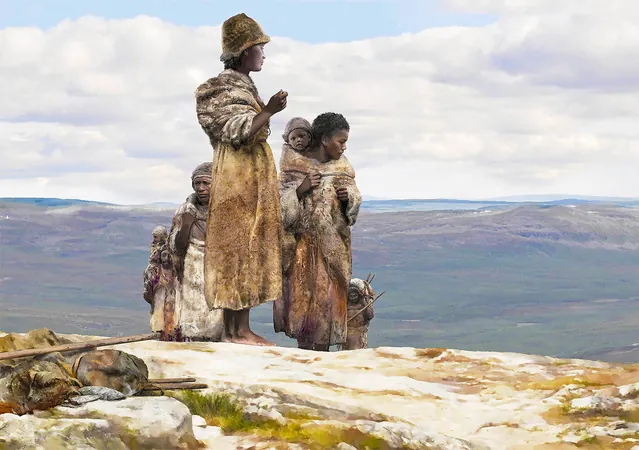
Uncovering a Lost Chapter of Human History: The Oldest DNA Links to Neanderthals
2025-06-13
Author: Wei
A Journey Back 45,000 Years
45,000 years ago, Europe was a frosty frontier, teeming with an unusual drama as modern humans ventured in from the southeast, encountering the Neanderthals who had thrived there for millennia. This fascinating intersection of two human species paints a vivid picture of shared lives—and shared DNA.
The Discovery of Ancient Bones
In a remarkable archaeological find, scientists excavated fragile bones from a cave in Germany known as Ranis. Dating back between 42,000 and 49,000 years, these remnants belonged to at least six individuals—men, women, and even infants. One striking discovery: a mother-and-daughter pair among the remains.
Across the border in Czechia, another key piece emerged—a skull from a woman who lived contemporaneously with the Ranis group. At first, researchers debated whether the two sites had any connection.
A Shocking Genetic Revelation
By analyzing the DNA from these archaeological treasures, scientists unearthed a shocking truth. The woman’s genetics linked her to individuals from the Ranis cave as distant relatives, suggesting these ancient humans were part of a broader community rather than isolated wanderers.
Unlocking the Tools of an Ancient Culture
The Ranis cave is notable for its evidence of a specific tool-making tradition known as the LRJ tools (Lincombian-Ranisian-Jerzmanowician). For years, debates raged over whether Neanderthals or modern humans created these tools. The answer became clear when both the tools and modern human bones were unearthed in the same location, confirming that early humans were indeed their creators.
High-Quality Genomes and a Family That Didn't Last
Researchers from the Max Planck Institute for Evolutionary Anthropology have accomplished the remarkable feat of sequencing the oldest, high-quality modern human genomes ever, including one known as Ranis13. Yet, intriguingly, these individuals seem to have no modern descendants—suggesting a fragile lineage that vanished.
A Distinct Lineage with an Unexpected Connection
This group’s Neanderthal ancestry doesn't resemble the more recent genetic mixtures found in later ancient populations, hinting they may have traveled a different route or encountered fewer Neanderthals. Their ancestry connects them to all non-African peoples, but without any recent mingling.
Estimating the Size of an Ancient Community
Scientists estimate that this early population consisted of only a few hundred individuals, revealing how precarious life could be during the Ice Age, competing for survival in an unforgiving environment filled with challenges.
Visualizing Our Ancestors
Genetic analysis indicates that these early Europeans likely had dark skin, dark hair, and brown eyes. This aligns with their African ancestry and marks them as pioneers who left their homeland to brave the frozen landscapes of Europe.
Legacy of a Brief Existence
As Johannes Krause, the study's senior author, highlights, these results deepen our understanding of early human pioneers. Their brief presence may not have left lasting descendants, yet their stories are ingrained in our genetic makeup, intertwining past, present, and future.
While they may not have become our ancestors, the legacy of the Ranis and Zlatý kůň groups is a testament to the complex narrative of human evolution—one of movement, connection, and survival.



 Brasil (PT)
Brasil (PT)
 Canada (EN)
Canada (EN)
 Chile (ES)
Chile (ES)
 Česko (CS)
Česko (CS)
 대한민국 (KO)
대한민국 (KO)
 España (ES)
España (ES)
 France (FR)
France (FR)
 Hong Kong (EN)
Hong Kong (EN)
 Italia (IT)
Italia (IT)
 日本 (JA)
日本 (JA)
 Magyarország (HU)
Magyarország (HU)
 Norge (NO)
Norge (NO)
 Polska (PL)
Polska (PL)
 Schweiz (DE)
Schweiz (DE)
 Singapore (EN)
Singapore (EN)
 Sverige (SV)
Sverige (SV)
 Suomi (FI)
Suomi (FI)
 Türkiye (TR)
Türkiye (TR)
 الإمارات العربية المتحدة (AR)
الإمارات العربية المتحدة (AR)